
The Hindlimbs
The hindquarters of the Boerboel has had a lot of emphasis put on it since 1995. This was when the breed had a large amount of dogs with straight rears. These days, there are many dogs with good rears and emphasis needs to be put back on the entire dog and not just one segment. Because of the distinct sexual dimorphism needed in the breed, a good rear is more important in the female than the male. Both should have correct angulation, but males should have less muscle and width in the rear when being compared to the female.
Are strong boned, sturdy and muscular.
There is that term “strong boned” again. Most of the bones in the rear are covered by muscle, except part of the stifle bone, and the metatarsus or what most people call the hock. The metatarsus should be noticeably thicker than, sometimes double, the visible part of the stifle bone.
The joints should be sound, strong and correctly angulated to support the powerful propulsion from the hindquarters during movement.
Sound joints are the most important point here. When a dog goes lame in the rear, there are three main points where things most often go wrong: The hips, the patellas, and the cruciate ligament.
The cruciate ligament can get ruptured when the dog does not have the correct angulations; often too much angulation will cause this problem. Sometimes, a dog will tear his cruciate ligament when walking or running on slippery surfaces. Usually, but not always, it tears due to some underlying problem
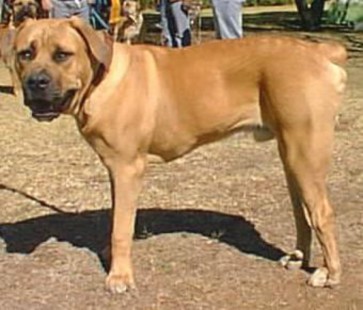
This dogs photo was taken specifically because it had all the wrong angles in its hind legs and front legs. Even his front foot is turned out facing the camera. Obviously he cannot have a good topline or movement, with such poor angulation in his legs. This dog is more susceptible to joint and ligament problems due to his poor construction.
The patella is like the dog’s knee joint. Sometimes, patella’s will move, causing trouble with a dog’s movement. This is called subluxating patella’s; it is often a genetic problem in some breeds. I have not seen it too often in Boerboels.
Hips are always a controversial subject amongst large-breed enthusiasts. The hips are a major load-bearing joint and need to be sound. If a dog can move effortlessly, without limping, for his entire life and live to be over ten, then his entire structure, including the hips, are sound. Bad hips can be due to the genes passed down from the parents. Bad hips can also be due to environmental issues such as, incorrect food, and injuries attained during growth. Hip injuries, or excessive wear and tear on the hip joint, can also be owed to bad angulation in the rear legs.
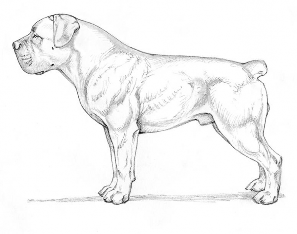
This drawing depicts the correct rear angulation and musculature for a male. When the rear is correct, and the front is correct, it allows the topline of the dog to be straight, and slightly sloping to the rear. When looking at the following drawings, take note of the effect that incorrect angulation has on a dog’s topline.
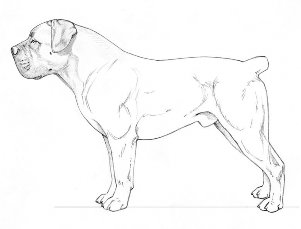
This dog is slightly under-angulated when compared to the breed standard. Because he lacks a bit of angulation, this in turn, affects his topline by raising it. Dogs with this amount of angulation can live a long, healthy life, and still move well. If you were to breed a line of dogs, you should aim for most of the dogs in your line to have angulation in-between the ideal and this depiction. Dogs with even a fraction more angulation than ideal should not be bred and you should try to avoid breeding dogs with less angulation than the above drawing.
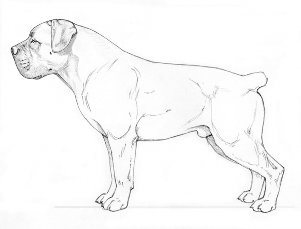
This dog is over-angulated and his top line slopes too much towards the rear of the dog (what some breeders call a “ski-slope” topline). When I look at this dog, he looks weak in the rear as if he has hip or spinal problems. Dogs with over-angulation cannot move well and are more prone to physical ailments like bad hips and torn cruciate ligaments. Slightly under-angulated is much healthier than slightly over- angulated.
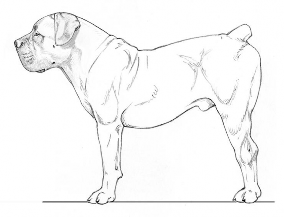
This dog has a very straight rear and straight shoulders as well. Both have affected his top line massively. This dog cannot move well and is more likely to have problems with joints the older he gets, because the weight is on the incorrect parts of the joints. Straight shoulders and stifles cannot hold as much muscle to them as correctly angulated ones can. Because there is no angulation in the rear, the dog’s back foot will sit further under the dog to support his weight.
The upper thighs are broad, deep and muscular as seen from the side and the rear.
I think musculature on the thighs has been exaggerated with some males. The muscle on the rear needs to be balanced with the muscle on the front. The front should always be wider than the rear. For females it is better to have the rear wider and carry more weight than the front. The muscle on the female should be noticeably softer than males.
The lower thighs have well defined muscles and show substance down to the hocks.
The metatarsus is broad, relatively short and perfectly upright. The front is in a vertical line with the rear of the rump.
A Boerboel must have thick bones; this applies to the hocks as well. I think I have already mentioned this, but it is so important that I will mention it again. The hock should be thicker than the stifle bone and comparable in thickness to the front legs. The hock should be perpendicular to the ground. The toes should be in a plum line from the point of the buttocks (the area that protrudes beyond the tail) to the ground. If the toes are behind this plum line, the dog is probably over angulated in the rear or “sickle hocked.” If his toes are in front of this plumb line, the dog is lacking in bend of stifle. Both of these faults are a weak hock assembly and will affect the dog’s movement and athleticism. It would be advisable to breed away from dogs with faulty hock conformation.
From the rear the profile of the hindquarters should form an inverted U, with the stifles pointing straight forward and the hocks straight backwards.
What the standard is asking here is that the stifle and hocks should be on the same plane and that plane should point straight to the front. So both legs are almost parallel when viewed from the top or behind. This is the same as most endurance-type dogs like Husky’s, Sheepdogs, Kelpies, and Border Collies. When the legs track straight, it is the most efficient construction for a dog, allowing him to move freely and effortlessly, for long periods of time.
What needs to be said here, is that the power dogs, those who need to explode off the mark, like Greyhounds, are actually slightly cow hocked, but with the hock and stifle bones of each individual leg still on the same plane. The only difference is that the planes will converge somewhere behind the dogs hocks. A slight cow hock not only produces more power, but it also looks more powerful when looking from behind, because it shows more of the dog’s thigh muscle. Although the standard asks for stifles pointing straight forward, a slight cow hock should not be discriminated against, as it is a good adaptation if you want more explosive dogs.
A dog with a powerful, correct front, and a slight cow hock at the rear, will accelerate faster than a dog with a perfect rear, and a correct front given all other things are equal.
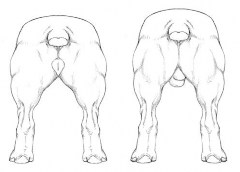
The female is wider when viewed from behind, even if she is smaller. With the stifles pointing straight forwards and the hocks pointing back. What is important here is that the stifle and the hock are on the same plane. So, if you were to cut off each leg and lay it on the
ground, keeping the same angles as when the dog is standing, the leg should sit flat on the ground. Often, I have seen dogs that look like they have good angulation from the side, but when you look from the rear or from above, the hock is on a different plane to the stifle bone.
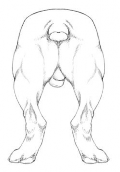
This is an extreme cow hock. Although not desirable, cow hocks are much better than the opposite, which are the hocks facing out. If a dog is cow hocked, the next thing to check is if the stifle and hocks are on the same plane. If they are, the dog should still be able to move well. Many breeds of actual, functional, working, performance dogs have varying degrees of cow hocks and perform at the top of their sport.
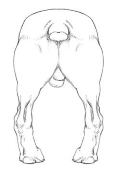
Bandy legs or Barrel hocks are the variation in the stifle that is the weakest and the least desired. When watching such a dog move from behind, you see how weak they look, their hocks wobbling with every step.
Dogs with barrel hocks are prone to bad movement and torn cruciate ligaments. They should be avoided in breeding programs.
The hind paws point straightforward, are slightly smaller than the forepaws but have the same quality.
If everything else is correct in the hindquarters, leading up to the paws, then barring injury, or arthritis, the paws will have to point straight forward.
